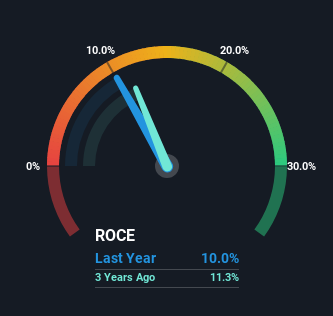Stock Analysis

What trends should we look for it we want to identify stocks that can multiply in value over the long term? Firstly, we'd want to identify a growing return on capital employed (ROCE) and then alongside that, an ever-increasing base of capital employed. This shows us that it's a compounding machine, able to continually reinvest its earnings back into the business and generate higher returns. With that in mind, the ROCE of Amcor (NYSE:AMCR) looks decent, right now, so lets see what the trend of returns can tell us.
Return On Capital Employed (ROCE): What Is It?
Just to clarify if you're unsure, ROCE is a metric for evaluating how much pre-tax income (in percentage terms) a company earns on the capital invested in its business. To calculate this metric for Amcor, this is the formula:
Return on Capital Employed = Earnings Before Interest and Tax (EBIT) ÷ (Total Assets - Current Liabilities)
0.10 = US$1.3b ÷ (US$17b - US$3.9b) (Based on the trailing twelve months to March 2024).
Thus, Amcor has an ROCE of 10%. That's a pretty standard return and it's in line with the industry average of 9.8%.
View our latest analysis for Amcor

In the above chart we have measured Amcor's prior ROCE against its prior performance, but the future is arguably more important. If you'd like, you can check out the forecasts from the analysts covering Amcor for free.
The Trend Of ROCE
While the returns on capital are good, they haven't moved much. The company has employed 51% more capital in the last five years, and the returns on that capital have remained stable at 10%. 10% is a pretty standard return, and it provides some comfort knowing that Amcor has consistently earned this amount. Over long periods of time, returns like these might not be too exciting, but with consistency they can pay off in terms of share price returns.
One more thing to note, even though ROCE has remained relatively flat over the last five years, the reduction in current liabilities to 23% of total assets, is good to see from a business owner's perspective. This can eliminate some of the risks inherent in the operations because the business has less outstanding obligations to their suppliers and or short-term creditors than they did previously.
What We Can Learn From Amcor's ROCE
In the end, Amcor has proven its ability to adequately reinvest capital at good rates of return. And given the stock has only risen 8.2% over the last five years, we'd suspect the market is beginning to recognize these trends. So to determine if Amcor is a multi-bagger going forward, we'd suggest digging deeper into the company's other fundamentals.
If you'd like to know more about Amcor, we've spotted 2 warning signs, and 1 of them is a bit unpleasant.
For those who like to invest in solid companies, check out this free list of companies with solid balance sheets and high returns on equity.
Valuation is complex, but we're helping make it simple.
Find out whether Amcor is potentially over or undervalued by checking out our comprehensive analysis, which includes fair value estimates, risks and warnings, dividends, insider transactions and financial health.
View the Free AnalysisHave feedback on this article? Concerned about the content? Get in touch with us directly. Alternatively, email editorial-team (at) simplywallst.com.
This article by Simply Wall St is general in nature. We provide commentary based on historical data and analyst forecasts only using an unbiased methodology and our articles are not intended to be financial advice. It does not constitute a recommendation to buy or sell any stock, and does not take account of your objectives, or your financial situation. We aim to bring you long-term focused analysis driven by fundamental data. Note that our analysis may not factor in the latest price-sensitive company announcements or qualitative material. Simply Wall St has no position in any stocks mentioned.
Valuation is complex, but we're helping make it simple.
Find out whether Amcor is potentially over or undervalued by checking out our comprehensive analysis, which includes fair value estimates, risks and warnings, dividends, insider transactions and financial health.
View the Free AnalysisHave feedback on this article? Concerned about the content? Get in touch with us directly. Alternatively, email editorial-team@simplywallst.com
About NYSE:AMCR
Amcor
Develops, produces, and sells packaging products in Europe, North America, Latin America, Africa, and the Asia Pacific regions.
Good value second-rate dividend payer.

